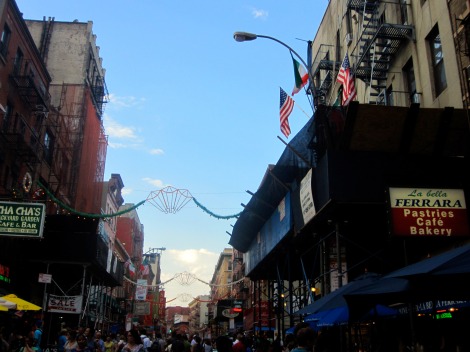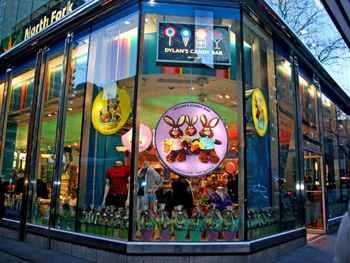
Immigration rates to America spiked in the late 19th and early 20th centuries. At that time, most newcomers came from Europe, although this statement is more complex than it sounds because not all Europeans were viewed the same way. The Irish were discriminated against because they looked different from other Northern Europeans, and Italians were discriminated against for being “not white.” We live in a very different world today, and although immigration levels plummeted in the years following the Great Depression, they eventually went back up to reach a new high. Today, very few of our immigrants come from Europe; most are from Latin America and Asia.
As I stated in one of my practice posts before the program even started, I was adopted and know little about my background. However, I do know that I am at least half Italian and Irish, and I was born in Connecticut. Therefore, the likelihood that at least one of my ancestors came through Ellis Island is very high. Our visit to Ellis Island last week, which was a first for me, was an incredible learning experience and I can say that I know far more about the topic of immigration and its historical context than I ever have before. There were ports besides Ellis Island, including such random places as New Bedford, MA, where many immigrants came through.
Of course, none of these places rival Ellis Island, where millions of immigrants came into our country for the first time. Many stayed in the New York City area, while others boarded trains and fanned out all across the country. In the upper midwest, most people can trace their ancestry to German immigrants who came through Ellis Island. New England is full of Irish and Italians whose great grandparents came through there as well. In fact, the South is the one region of the country where few immigrants from anywhere chose to settle, for various reasons. This has been changing in recent years though, as the Hispanic population in places like North Carolina and Georgia has been exploding.

The above photo is a famous one, and depicts an immigrant family who has just arrived in America. Above the little boy’s head, in the distance, is the statue of liberty. I love these types of pictures, and photography in general, because it provides me with a moment in history, frozen in time. This is an image of a real family, and this event actually happened. I can think back, and imagine myself as an immigrant from Italy in the year 1910, who has just arrived in New York after a long trip across the Atlantic. At 21, I came over with my parents and four siblings. All of us only speak Italian, and while we know a few other people from back home who had moved here too, we are still in a strange new land with no clue what the future holds.
I have been to many countries before, and I felt like a complete and utter stranger every time, even when locals spoke English. In Japan, nobody spoke
English, and everything looked so different. I hated it, and was actually depressed for the entire three weeks I was there. It had nothing to do with the people, who were very kind and welcoming, or the culture, which is fascinating. It was just so alien and hard to adjust that I had a lot of trouble. So, I can only imagine what it would be like for me a hundred years ago to actually move to a new land that I knew little about. To make matters worse, much of what we would had heard was probably untrue.
On the wall at Ellis Island was a quote by a Polish immigrant, which said something along the lines of: “I had heard that the streets in America were paved with gold…when I arrived, I learned that not only were they not paved with gold, but that we were expected to pave them.” The United States had a major propaganda campaign across Europe enticing immigrants to move. The attractions of cheap labor and population growth, which keeps economies strong, are the same reasons why our government and corporations today want immigrants to come so badly. Of course, back then, most immigrants who came here lived in horrible poverty. Sections of NYC were filled with tenements that housed multiple families at a time, and hygiene was virtually non-existent. However, my family would have taken it in stride. We lived in poverty in Europe, so even if we started off poor here, at least we were in America.
I would have learned English pretty quickly, because it would not have been like high school spanish class. When you are immersed in a culture, you pick up the language and customs rather fast. It is a survival instinct. Of course, the place I lived in the city would probably be full of other Italian immigrants, which would help me a bit to feel more at home. It becomes harder with age to adjust to a new culture, so my parents would likely have the most trouble with that. I have friends who immigrated here years ago with their whole families from places like China, and their grandparents still cannot speak much English or get used to American food. Fortunately, being 21 would help me out a lot with those things.

When speaking about the immigrants of today, I would like to first say that most of them are very good people who came here legally, follow our laws, work hard, and make America an even better place to live. I know scores of these people, and my life would not be the same without them. Unfortunately, we also live in a society and a culture where rampant liberalism, starting in the sixties, has really begun to tear apart our nation. It is almost as if illegal immigrants have more rights than real Americans do.
Lets take, for example, the State of California. California is an economic trainwreck, and most anyone who lives there will tell you why. It is in part due to millions of illegals who have inundated the state and cost billions of dollars in services while paying little back in return. In 1994, California voters overwhelmingly passed Prop. 187, which prohibited illegal aliens from using social services. So widespread was support for the initiative that it only failed in a handful of Bay Area counties, which is to be expected, as San Francisco has been a breeding ground for insanity since the fifties.
Somehow, Prop. 187 was thrown out by a left wing judge, and disgraced former Governor Gray Davis refused to appeal the decision. So, basically, a judge said it is unconstitutional to prohibit non-Americans from being in America and using services that Americans pay for. It is mind blowing that this type of injustice can happen in the USA, but it is easy to see how this sense of entitlement has spread to other countries and encouraged even more illegals to come here. They come by the millions, trample over our land, destroy people’s property, commit crimes, use up social services that Americans are spending billions on in taxes, and suck this country dry. This never would have happened a hundred years ago, because back then, you had to learn English and get a job and follow our laws to even get here in the first place. I don’t know of any Italians swimming to America illegally.
There are now Mexican nationalist groups, such as La Raza, who advocate taking back the entire southwest for Mexico. With the Hispanic population in New Mexico now a plurality, and a huge, growing minority in every other state out there, does this really sound impossible? People in government don’t understand the national security threat that illegal immigration poses. Everyday Americans do, though, which is why we have things like Prop. 187 and the recently passed Arizona Immigration Law, which has received way more controversy than it is due. All that does is give law enforcement the ability to check for documentation AFTER an individual has already been stopped for committing a crime. Why is this even an issue?
President Obama is actually suing the State of Arizona, which has caused me lose all respect for him. Entire liberal city councils, like in LA and San Francisco, are voting to boycott Arizona. Absolutely nuts. I think that Arizonans have seen what a disaster California has become, and they don’t want it to happen to them too. Even most democrats support the Arizona law, according to every poll. Governor Jan Brewer is seen as a hero in Arizona for doing something about this problem. I would tell anyone who opposes this law to actually read it, as I have, rather than listening to ridiculous liberal propaganda and lies. Then, I would encourage you to pay a visit to Arizona. See what it is really like and how big the problem is before passing judgement. White liberals in the North who have never even seen an immigrant outside of a taxicab have no right to whine about this bill.

Of course, there is a positive side to immigration too, as I noted earlier. My last few paragraphs were about illegal immigration, because of the massive threat it poses and the refusal of our elected officials, including a lot of republicans even, to do anything about it. however, America takes in around a million legal immigrants every year, and these people are by and large very hard working. If I lived in an impoverished nation with little hope of having a bright future for my family, I would want to leave too. When I did get to America, I would do whatever it took to provide for my kids. I love people like this, because they give up their entire life and everything they have known to come to a strange new land and try to make things better. Which, by the way, they do.
We have immigrants working in fields, factories, and all the other places that they always have worked. However, we also have immigrants doing incredible things. They become inventors, like Albert Einstein, or movie stars and later politicians, such as Arnold Schwarzeneggar. Perhaps most significantly, a huge number of them fight for our country in the armed forces. I know a lot of immigrants who work harder and have achieved more than native-born Americans. One of the reason why our country is the power that it is is because of our diversity. We get all the best ideas from all over the world, and that makes us incredibly unique and special. Our national sovereignty and law enforcement is important, as it is to any civilized society. But it is the diverse array of minds that has made us what we are. In most countries, immigrants are allowed, but can never assimilate to the point where they are accepted as a native member of that said society. America is different, and I would never want to live anyplace else.





























